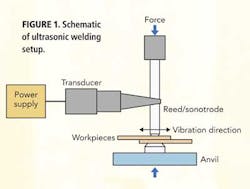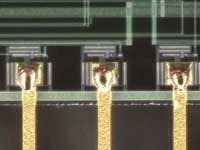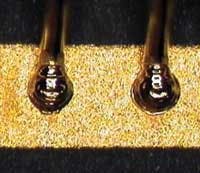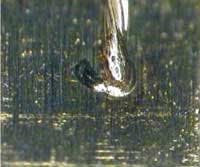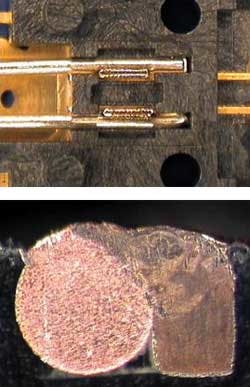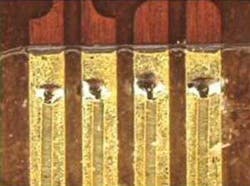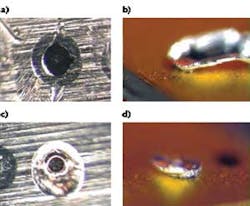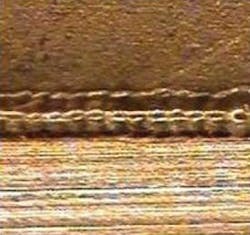Green lasers for laser micro welding
Connecting conductive parts to achieve electrical contact is one of the oldest, most ubiquitous joining applications. Required in almost every industry, the technologies used to make these connections are driven by cost, joint performance and volume requirements.
As part miniaturization continues, and connector sizes decrease below 0.004 in. thick for flat ribbons and wire diameters, such traditional processes as crimping, soldering and brazing techniques become less viable due to high joint resistance, questionable joint reliability and longevity. By contrast, welding, which provides excellent joint integrity, longevity and conduction performance, is quickly becoming the required standard. For joining two materials where at least one is less than 0.02 in. in thickness, the technology required is called "micro welding."
Copper is typically the material of choice for connecting conductive parts using micro welding, because of its superior ability to efficiently conduct electrical energy and transmit signals. However, the very high thermal conductivity that makes copper such a good choice as a conductor rapidly pulls heat away from the weld joint, making it difficult to maintain heat balance and weld reliably. This difficulty is further exacerbated by trends toward increased production rates, reduced part size, and welding of dissimilar materials and dissimilar conductor cross sections. The challenge of micro welding copper is how to control the heat balance in these small and highly conductive parts to enable welding while ensuring no over- or under-heating. One way of meeting this significant challenge is by using a 532 nanometer (nm), or green wavelength.
Pluses and minuses of traditional micro welding techniques
Micro welding can be done using several options: ultrasonic bonding, resistance welding, and laser welding. Each has its advantages and disadvantages and each meets micro welding requirements somewhat differently.
a) Ultrasonic bonding: well suited to sheet welding but may cause reduced production rates
Ultrasonic bonding (FIGURE 1) uses vibration energy at the joint interface to create the bond. The vibration energy is delivered to the interface by a sonotrode or horn that contacts the top part. The horn vibrates at frequencies of hundreds to thousands of times per second, with motion amplitude of between 0.0005 to 0.004 in. The underside of the part is supported with an "anvil," which can be either static or also vibrating.
The vibratory action under applied force causes plastic deformation of surface disparities at the weld interface, leading to highly intimate contact and a diffusing of metallic atoms. The joint forms by diffusion and there is no melting at the joint. There is some deformation or thickness reduction of the parts, but this can normally be controlled. Contact of the horn to the part is maintained by the horn's friction, enhanced by a knurling pattern on the horn along with a force applied on the parts.
Ultrasonic welding is particularly well suited to sheet welding of conductive parts, including aluminum and copper. The ultrasonic process has some drawbacks for micro welding. Since force is imparted onto the parts, mechanical contact is required on either side of the joint. Also, the horn is a consumable that requires inspection and replacement. Joint geometry is somewhat limited to lap welding only. Finally, the speed of the welding cycle that involves actuation of the horn can slow production rates.
b) Resistance welding: flexible process, but not suitable for mechanically delicate parts
Resistance welding uses the weld interface's high resistance to create heat as current is passed through the parts. The circuit is created by electrodes that contact the part either from the same side or opposite sides of the workpieces. Electrical contact is assured by exerting some force on the parts.
When resistance welding conductive parts, the electrodes are resistive and therefore perform two functions: they heat up and conduct heat to the parts and they conduct sufficient current to enable some heating to occur at the joint interface.
Resistance welding works well for a wide variety of joining applications and materials. However, since the resistance welding process relies on mechanical contact and the need to create an electrical circuit between two electrodes, it may not work properly in all circumstances, especially if the parts are mechanically delicate. In addition, the minimum electrode size is around 0.04 in. in diameter, and so this may limit joint accessibility.
c) Laser welding: non-contact process is fast and accurate, but material reflectivity issues must be addressed
Laser welding is a non-contact process, requiring only single-sided access. The technology is useful for working on extremely small joint areas, and can be used to weld different shaped parts, different joint geometries, and dissimilar materials. It uses no consumables that need to be maintained or replaced and the weld cycle is milliseconds. On the face of it, laser welding appears to be an excellent solution for copper micro welding - but there is a problem. The pulsed Nd:YAG (neodymium-doped yttrium aluminum garnet) used for the majority of micro welding applications has a wavelength of 1064 nm, which is more than 90 percent reflected by copper.
Extremely high power is required to overcome the reflectivity and to ensure that sufficient light energy is delivered to the copper to initiate. However, once some laser power is delivered to the copper and raises its temperature, the reflectivity decreases. As the absorption of laser power occurs in times scales of less than a billionth of a second, there is a rapid change in how much power is absorbed. The high power that was initially required now far exceeds what is required to form the weld. As a result, the material rapidly overheats and vaporizes, leaving a large porosity or a hole.
Comparison of reflectivity for 1064 and 532 laser wavelengths
Material | Wavelength | |
1064 nm | 532 nm | |
Copper | 90% | 45% |
Gold | 98% | 42% |
A number of techniques have been used to overcome this reflectivity, including pulse shaping, oxygen assist, and the use of less reflective platings. Pulse shaping is not reliable, because the reflectivity of copper and other conductive parts varies, and so the precise moment at which the laser power should be reduced also varies. There have been some attempts to better anticipate this 'precise moment' by implementing feedback techniques, but none have so far proven viable. Oxygen has been shown to dramatically increase penetration in seam welding copper by building an oxide layer on the part to be welded, but this has not been effective for spot welding applications because the positive effect of oxygen is seen only after several pulses in succession and so does not offer a reliable technique for single spot welding or short seams. Using less reflective coatings such as nickel or tin does help to reduce initial reflection, but does not fully alleviate the problem as large energies are still required to continue the coupling into the copper; thus the process window for micro welding becomes very small.
Pulsed green lasers address material reflectivity issues
As discussed, material reflectivity must be addressed to achieve a good, strong laser micro weld on copper. As shown in the table above, reducing the wavelength from 1064 nm to 532 nm significantly reduces the reflectivity of copper and other conductive materials. The 532 nm (green) wavelength enables consistent coupling into the copper and stabilizes welding.
FIGURE 2 shows the comparison of 1064 nm and 532 nm wavelength welding of uncoated copper. At 532 nm, the laser couples into copper as 1064 nm couples into steel. Therefore, successful micro welding of copper can be achieved if a 532 nm laser is used.This wavelength can be achieved in two ways. Most common is to use a q-switched laser, but such a laser does not have sufficient pulse energy to weld.
A more novel approach is to use a regular pulsed Nd:YAG laser, which offers 532 nm light at 1.5 kilowatt (kW) peak power with up to a 5 milliseconds (ms) pulse width. This provides enough weld energy to penetrate approximately 350 microns thick copper, which is sufficient for most micro welding applications. Another additional benefit of using a pulsed Nd:YAG laser delivered through a fiber is that the beam has low brightness. This promotes even absorption across the focus spot, preventing hot spots at the center of the weld that may cause instability.
Real world examples of green laser micro welding applications
Electrical connections come in many different sizes, shapes, and materials. The requirement for high quality, reliable terminal connections occur in many industries. The welding of electrical contacts needs to be a seamless process to the operation of the part, such that the joint performs as a single solid continuous component. Laser welding offers this potential.
For example, the automotive industry has seen a significant increase in sensor technology to monitor car performance, functionality and environment. Each sensor has many terminal connections that must survive for the lifetime of the car. In this arena, laser micro welding provides a viable option, and the laser provides a great tool for high speed high quality welding.
Connection requirements are also critical in the medical industry, for example in implantable devices, sensing and monitoring instruments, where each connection is critical to maintaining part functionality and performance, and thus requires a highly stable joining technology.
Similarly, in the communications industry, signal strength and integrity are crucial to maximize part performance and ensure that the joint is not a limiting factor to the part's design.
There are a number of electrical contact configurations that are needed across all industries chosen according to specific part and component design. A few of these connection options that can be accomplished using the pulsed green laser are shown here.
Flat ribbon to thick film metalized pad
A common connection in the electronics industry is shown in FIGURE 3, where a 0.00150 in. thick gold coated copper flat wire is bonded to metallized pads. Ideally the pad thickness is at least 1.5 times the thickness of the ribbon, because this creates a good thermal balance between the wire and the pad preventing the pad from overheating.Wire to metalized pad/terminal
Joining solid and stranded wires is another common terminal configuration for power electronics. By suitable positioning of the laser to the tip of the wire and the pad, the wire is effectively reflowed on the pad. Also note in FIGURE 4 the absence of heat effect on the pad itself.Side by side square terminal to round wire
The flexibility of the laser is extremely valuable in welding different joint geometries and terminal shapes. FIGURE 6 shows a weld between a gold-plated copper connector of rectangular cross section to a silver-plated copper wire. The weld is made in a butt configuration, with the position of the wire in relation to the terminal showing some variation plus the gap between the wire round and the square edge of the terminal. The controlled and consistent absorption of the laser power to both parts enables the weld to be made reliably.Flat to flat lead frame connections
For high volume production, welding multiple joints on lead frames is all about quality and speed. Being a non-contact process, laser welding lends itself to volume manufacturing. It can execute many welds per second, according to the motion integration. FIGURE 7 shows a flat wire welding to a copper lead frame.Miniature lithium ion/polymer battery connections
Power application that require less than 50mAh for such applications as wireless products, smart cards, or RFID tags, generally use either lithium ion or lithium polymer battery technology. For these applications that require the battery terminal to be connected, there are a number of special challenges. Each terminal is made of copper and aluminum, which are both problematic to weld. The terminal material is also very thin, sometimes less than 0.001 in. In some applications, ultrasonic welding is used, but laser welding is also an option, and may be especially well suited to joining terminals to PCB metalized pads. FIGURE 8 shows several views of laser welding of thin copper and aluminum to gold coated copper pads.Micro welding of dissimilar materials
When welding materials with different levels of absorption, there is a tendency to overheat the more absorptive materials, causing excessive spatter and porosity. This is usually overcome by favoring one material. However, for small parts, this may not be sufficient because even the tiniest absorption imbalance can create an overheated weld. At 532 nm wavelength, the reflection of both parts becomes closer, therefore the weld energy balances more consistently, significantly improving weldability. FIGURE 9 shows a seam weld between two very different materials.Laser welding—viable method for high volume micro welding of copper
Micro welding of such conductive materials as copper is a difficult proposition, but laser welding offers a useful non-contact joining method, well geared for automation. In the past, copper's reflectivity at the 1064 nm wavelength has always been the barrier to implementing laser welding. By using a 532 nm green Nd:YAG laser welder, this barrier has been removed, offering a viable method for micro welding copper and other conductive materials in high volume.
Geoff Shannon, Ph.D. | Director Strategic Marketing for Precision Manufacturing, Coherent
Geoff Shannon, Ph.D., is Director Strategic Marketing for Precision Manufacturing at Coherent (Santa Clara, CA) and an Editorial Advisor to Industrial Laser Solutions. He previously served as Laser Technology Manager for Miyachi Unitek, specializing in the development of lasers and applications for existing and new markets. Shannon has a BEng in Mechanical Engineering and PhD in Laser Welding Technology from the University of Liverpool. His 20-year career in laser technology has centered around applications research and development and new product development of lasers and systems.
Paul Severloh | Sr. Laser Welding Applications Engineer/Process Development Engineer, Amada Miyachi America
Paul Severloh is Sr. Laser Welding Applications Engineer/Process Development Engineer at Amada Miyachi America (Monrovia, CA).
